Let’s learn the ins-and-outs of the major and minor pentatonic scale in today’s guitar lesson.
Over 100,000 guitar-learners get our world-class guitar tips & tutorials sent straight to their inbox: Click here to join them
In this free lesson you will learn…
- How to play the major pentatonic scale in both one and two octaves
- How to play the minor pentatonic scale in both one and two octaves
- Tips for ear training using these scales
- How to use these scales over backing tracks
- Tips for better scale practice
Ready For Your First Pentatonic Scale Guitar Lesson?
If you’re reading this, you’re probably ready to take your first steps into the world of lead guitar playing.
You’ve probably mastered a few chords, jammed to a few songs and thought “what else is there that I can do with this majestic instrument?”
You’ve most likely discovered how awesome guitar solos sound, and want to try and pull off something like that for yourself.
Are we getting warm?
If so, you’re in the perfect spot for your first pentatonic scale guitar lesson.

In this lesson, we’re going to unravel the secrets of one of the most common guitar scales for beginners:
The pentatonic scale.
This scale is about as versatile as they come – able to insert itself naturally into almost any chord progression without sticking out like a sore thumb.
Though it might contain less notes than some other scales you may have heard of, pentatonic scale guitar playing is ideal for guitarists who are just getting their feet wet with soloing.
From blues to rock, pop and so much more, the pentatonic scale fits perfectly amongst most chords.
Let’s explore more about it below.

Pentatonic Scale Guitar Playing Is Easy!
Using only five notes, this scale is quite easy to manage for any guitarist of any level.
The pentatonic scale is made up of the bare essential notes needed for it – nothing more.
Unlike other guitar scales, you won’t find yourself moving around more than one position in order to play all of the notes in the scale – the pentatonic scale’s root position is fixed in a four-fret box.
This means that it is much easier to memorize than other scales that may require a bit of extra movement to play.
There are two main types of pentatonic scale guitar shapes that we will look at as beginners:
The major & minor pentatonic scales.
Let’s learn about them below!
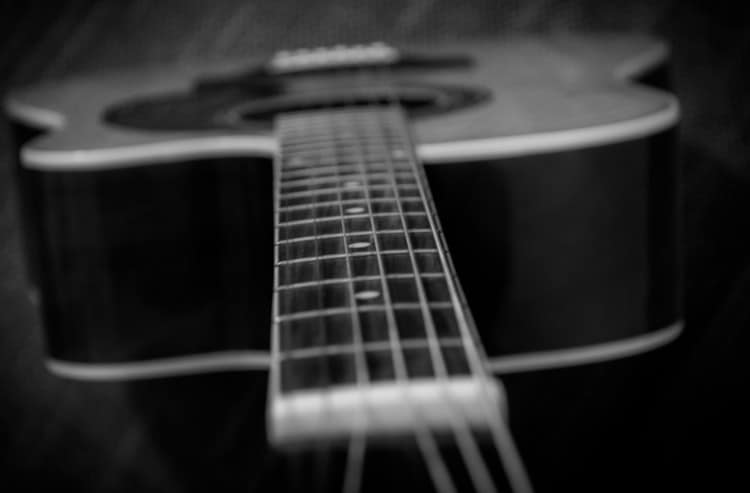
Each of these shapes is derived from a larger scale:
The minor pentatonic scale has two notes less than the minor diatonic scale.
The major pentatonic scale has two notes less than the major diatonic scale.
Regardless of being major or minor in nature, both of these pentatonic scale guitar shapes work perfectly over genres like blues, rock, country and even pop music.
Many guitarists start off learning only the minor pentatonic scale guitar shape, but we’re going to teach you both in this lesson so that you have more to work with.
We’re also going to show you how to use them both when learning how to solo over a chord progression.
But first, we’re going to look at the patterns themselves to understand what to play and how.
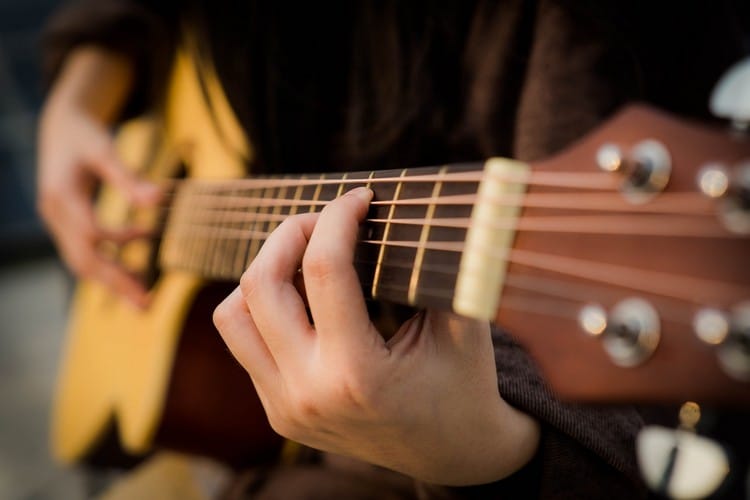
Download our lead guitar cheat-sheet to make things easier
It's hard to understand which scales work with which keys.
So we created a cheat-sheet! A key and scale-finder that you can use again and again.

Get your personalised guitar-learning plan 🎸
Get a custom guitar-learning plan here: Click here for GuitarMetrics™
World-Class Guitar Courses 🌎
Learn from the world's best guitar educators: Click here for our guitar courses
Pentatonic Scale Guitar Lesson I: Understanding The Minor Pentatonic Pattern
When we look at a scale as a beginner guitarist, it’s important to look at the shape of the scale to outline where our fingers should go.
The minor and major pentatonic scales have different scale patterns that we need to memorize in order to get the most out of each of them.
Many guitarists will tell you that pentatonic scale guitar playing involves memorizing all of the shapes across the fretboard – they would be right, but you as a beginner don’t need to focus on that just yet.
In this lesson, we’re going to focus on the root-position scale shapes for major and minor pentatonic scale guitar playing.
Let’s begin with the minor pentatonic scale in the key of A.
A MINOR PENTATONIC SCALE
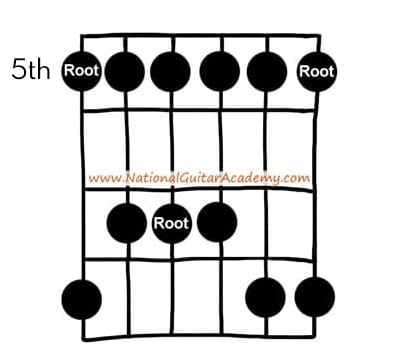
You’ll notice right away that you only need four frets to play this pentatonic scale guitar shape, so go ahead and line them up starting with your index finger at the 5th fret.
You might also notice that you don’t need your middle finger at all for this scale (we’re saving it for the major pentatonic scale guitar shape anyway).
The A minor pentatonic scale shape makes heavy use of the pinky finger on the 8th fret, which serves as a great opportunity to start actively using that finger if we haven’t already.
Pro Tip: If you’re not ready to use your pinky finger in practice just yet, you can also try this reduced shape in the open position:
A MINOR PENTATONIC SCALE
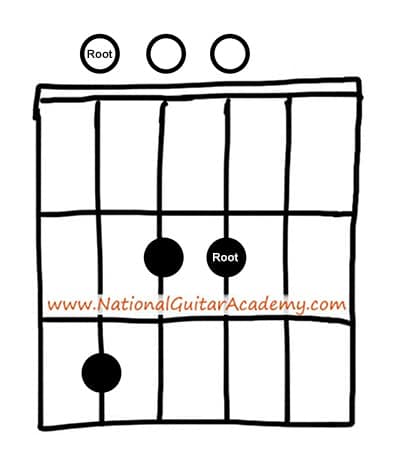
Pentatonic Scale Guitar Lesson II: Understanding The Major Pentatonic Pattern
Before we continue, there’s something interesting about this scale that you should know:
The major pentatonic scale can use the exact same notes as the minor pentatonic scale, and in the same key too!
This is called a relative major pentatonic scale, meaning that the scale in question is relative to the minor pentatonic scale.
The C major pentatonic scale uses the same notes as the A minor pentatonic scale.
Let’s compare the notes below:
C major pentatonic:
C – D – E – G – A
A minor pentatonic:
A – C – D – E – G
C MAJOR PENTATONIC SCALE
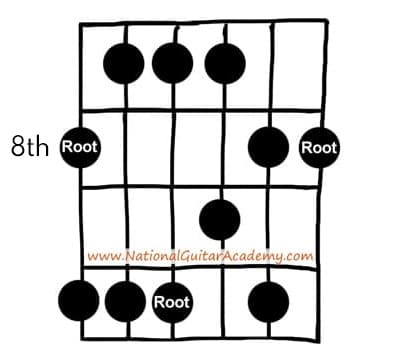
Did you see the similarity between the two scales?
They’re the same notes, just arranged differently. The arrangement of the notes is what gives them their individual flavour, and this is true of every scale in the music world.
For the C major pentatonic scale guitar shape, we’re going to want to start with our middle finger at the 8th fret and use our index finger for the 7th fret.
Pro Tip: Try playing through this scale and say the notes out loud as you play them – this way, you can identify what they sound like more easily.
If you’re not ready to play the two full octaves of the major pentatonic scale guitar shape, you can try this easier C major shape in one octave at the third fret of the A string:
C MAJOR PENTATONIC SCALE
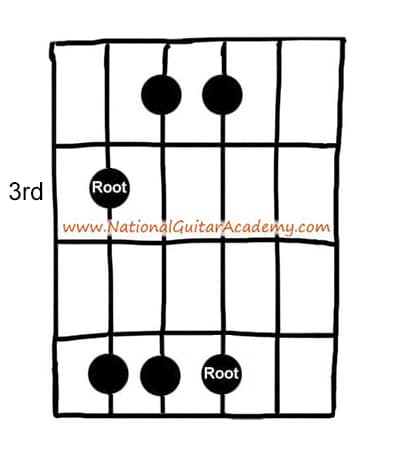
Pentatonic Scale Guitar Lesson III: Why Does Finger Placement Matter?
Here’s the thing about playing guitar scales: They don’t have to be difficult.
Pentatonic scale guitar shapes are commonly overwhelming to beginner guitarists because they don’t yet have a system for approaching them effectively.
By simply keeping each finger in its rightful space within the scale shape, we can make it easier to navigate these scale shape boxes.
The best part about scale shape boxes like these is that (when played properly), they require zero fretboard movement outside of the four-fret box.
Pro Tip: It’s a good idea to stretch before playing pentatonic scale guitar shapes such as these, as the pinky finger stretch might be a bit much for some of us.
The biggest takeaway in learning these pentatonic scale guitar shapes is not even the scales themselves, but how the scale shapes force us to compartmentalize our playing.
By teaching ourselves these scale shapes in four-fret boxes, we allow ourselves to build smaller patterns inside that box that help us give life to the scale in different ways (more on that below).
Try This: Once you have played through the major and minor pentatonic scale guitar shapes a few times, try playing notes from the scale out of order to get a feel for how the notes sound when re-arranged.
We’re going to get into how to use these scales melodically below, so keep this in mind in the meantime.
Before that though, how do we create a good sense of musical motion in these scales?

Pentatonic Scale Guitar Lesson IV: Alternate Picking Creates Fluid Motion
It’s one thing to simply play these scales note-for-note, but we want to create a sense of musicality in everything that we play.
This is where the technique of alternate picking comes in especially handy.
Alternate picking is exactly what it sounds like – picking in alternating directions.
This technique helps us steer away from the standard downpicking technique that most of us start with as beginners.
Although downpicking is great to begin with, it has its disadvantages compared to alternate picking – this is why we encourage all of our students to get acquainted with alternate picking as soon as they can.
So how do we learn this technique effectively?

To execute this technique, begin the first note of the pentatonic scale guitar shape with a downstroke, then follow up with an upstroke. Repeat this motion all the way up the scale.
You will notice that pentatonic scale guitar shapes lend themselves quite well to alternate picking, as both the major and minor pentatonic shapes use only two notes per string.
This means that you will always begin a new string on a downstroke, making it easier to manage your alternate picking.
Pro Tip: It’s less advantageous to start an alternate picking pattern on an upstroke, because it essentially goes against the natural direction of your hand when picking. Make sure to start on a downstroke whenever possible, and your picking will flow more naturally.

Pentatonic Scale Guitar Lesson V: Practicing Melody Over A Progression
Once we’ve gotten through practicing the major and minor pentatonic scale shapes on their own, we need to add some more musicality to the equation.
This is where the next phase of learning pentatonic scale guitar shapes comes into play:
Improvising with them.
Don’t get us wrong, we’re not asking you to play a Miles Davis jazz odyssey with these scales – we just want you to play around with them.
That’s why we scoured the internet for two blues-y backing tracks for you to play over.
Before we hand you over to YouTube for this section, let’s examine a few principles of soloing over these tracks below.

When we learned our major and minor pentatonic scale guitar shapes above, we mentioned that the C major and A minor pentatonic scales shared the same notes in a different order.
This brings us to an awesome teachable moment: Exploring how each of them sounds over a chord progression in that respective key (either A minor or C major).
Try This: Try the two jam tracks linked below, but try them in two ways. The first jam track is in A minor – play the A minor pentatonic scale guitar shape from above over it, followed by the C major pentatonic shape.
The second track is in C major – do the same as above.
Compare how each scale sounds over each progression!
Jam Track #1 – A Minor Pentatonic
Jam Track #2 – C Major Pentatonic

Learn 12 EASY beginner chords with our popular guide

✅ Stop struggling. Start making music.
✅ Learn beginner-friendly versions of every chord.
This is our most popular guide and it will improve your chord ability quickly! 😎
Get your own personalised guitar-learning plan 🎸
Get a custom guitar-learning plan here: Click here for GuitarMetrics™
World-Class Guitar Courses 🌎
Learn from the world's best guitar educators: Click here for our guitar courses
BONUS: Pentatonic Scale Guitar Lesson VI: Training Your Ears
If you’ve gotten through this lesson and you’re feeling confident in your ability to play even one octave of these pentatonic scale guitar shapes, there’s only one thing left to do:
Start training your ears!
Ear training doesn’t have to be its own exercise – you can practice ear training with just about anything even remotely musical.
Before we get into the how of ear training with these shapes, let’s review the shapes and their notes one last time:
C Major Pentatonic:
C – D – E – G – A
A Minor Pentatonic:
A – C – D – E – G
It’s important to note that these are the only notes in these scales, meaning that they repeat once they’ve completed their first octave.
C MAJOR PENTATONIC

A MINOR PENTATONIC

Here’s how this ear training exercise works:
For every note that you play, say the name of that note out loud.
If you haven’t, start trying to sing the notes out loud as well. It won’t be pretty the first few times through, but your ear will begin to get a feel for what each note sounds like.
The more you do this, the more accurate your singing and your ears become.
Singing your notes on any scale might seem rudimentary and boring, but it’s honestly one of the best things that you can do to help your musicality as a beginner guitarist.
Pentatonic scale guitar shapes open us up to a world of musical possibilities, so don’t sleep on this exercise!

How To Improve On Your Major & Minor Pentatonic Scales
If you still want more out of these exercises, we’ve got a few more tips for you below:
- Practice with a metronome to work on your timing. Metronomes also help us master alternate picking, so make sure you’re picking back and forth through these scales. Click here for a free metronome.
- Listen to artists that use these scales!
- Stevie Ray Vaughan
- Buddy Guy
- Slash & Company
- Zakk Wylde
- Start incorporating techniques like hammer-ons and bends into your practice to play through these scales in different ways
Recommended Resources
If you enjoyed this lesson on pentatonic scale guitar fundamentals, you’ll love the other lessons we’ve got laid out for you below:
- Guitar Techniques – 8 Tricks That Help You Sound Amazing
- The Ultimate Guide to Guitar Tone
- 8 Tips For Stronger Fingers
- The Best Way To Practice Guitar
- The Seven Levels of Guitar Chord Practice
What Type of Guitarist Are You?
Take our 60-second quiz & get your results: Take The Quiz
Join the world's best online guitar school 🌎
- Get your own personalised guitar learning plan (customised just for YOU).
- World-class online guitar courses. Learn at your own pace.
- Community Campus & Learning Forum - A friendly community! Connect with our team & students. 😊
- Beginner Song library with chordsheets, tabs and tips. (Songs suitable for all levels!)
- Regular live streams, seminars and Q&A sessions - Learn from world-class guitar educators. Get all your questions answered!
Click here to learn more about National Guitar Academy membership 
Cool Guitar T-shirts 😎
Look cooler! Check out our merch: Click here to see our merch store
Want free guitar tips and video lessons delivered to your inbox?
Join over 100,000 guitar-learners and subscribe to our guitar-tips-by-email service. (It's free.)
We'll send you a series of lessons that will move you to the next level of your guitar journey.
Learn how everything fits together quickly, easily and effectively. We share ninja tips (for instant fun!) but also timeless fundamentals that will deepen your understanding.

Popular Lessons
How To Learn Guitar: An 11-Step Programme For Beginners
How To Choose The Perfect Beginner Guitar
More Cool Guitar Stuff
Learn about National Guitar Academy: About Us
Join us on Facebook for daily guitar tips.
Listen to our Learn Guitar Podcast for rapid guitar progress.
Check out our free chord lessons.
Get our best guitar tips & videos
Where should we send it?
Where should we send it?
Get our best guitar tips & videos



